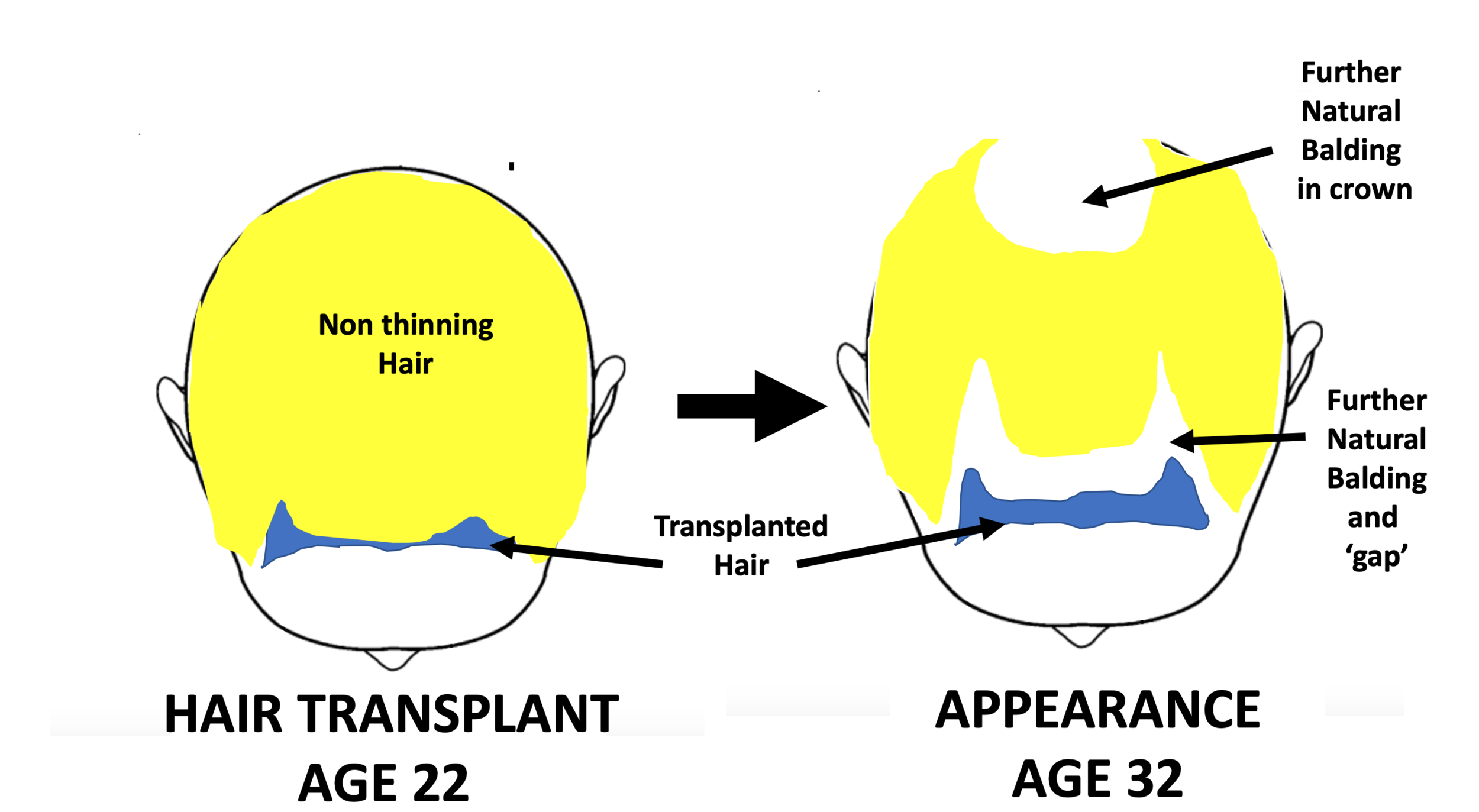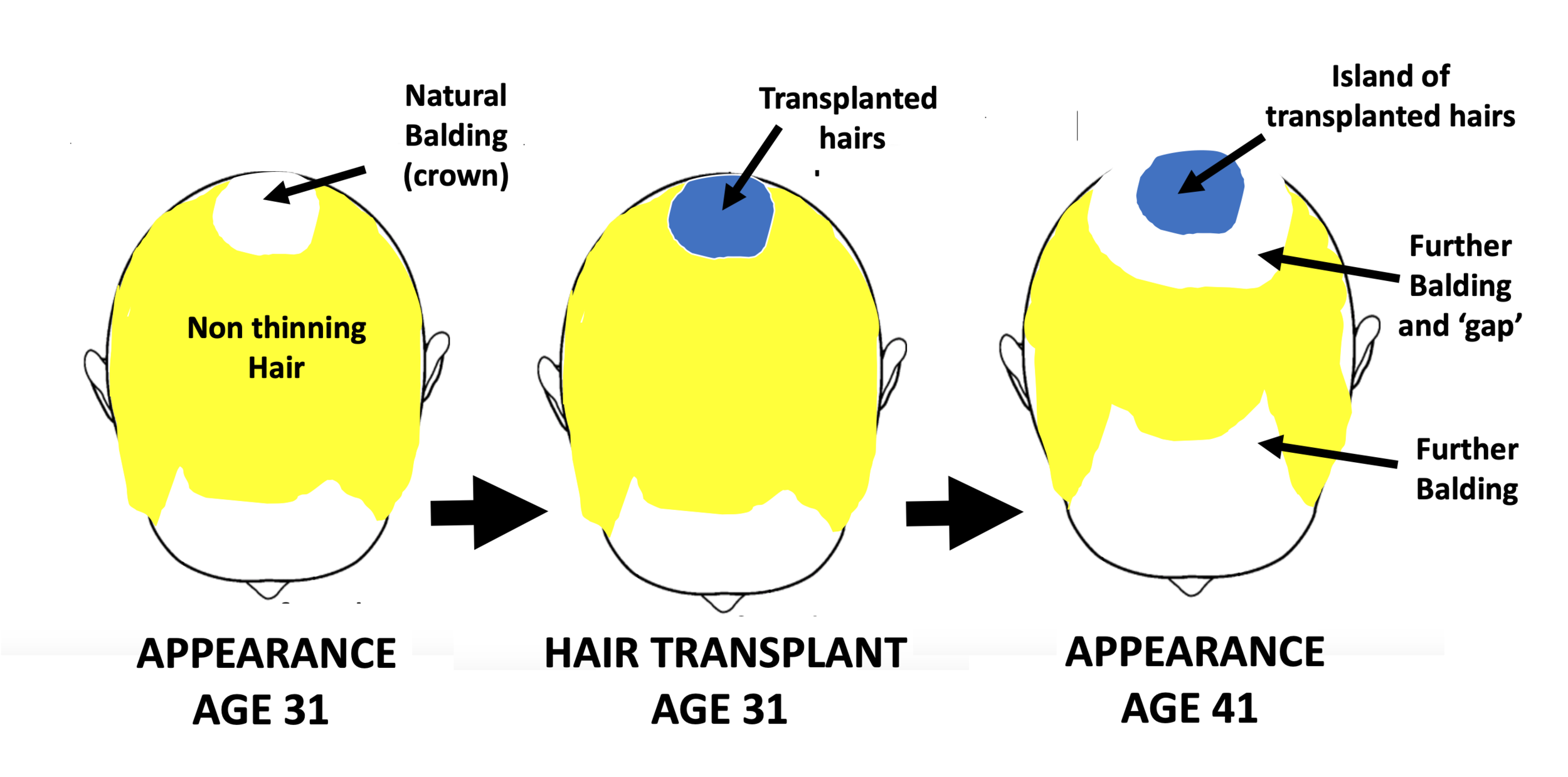Hair Transplant: Who is likely to feel it wasn't a good idea?
Which groups are most likely to feel having a transplant probably wasn’t a good idea?
Hair transplants are little miracles really. To think that one can move these little minorgans from one spot to another and have them grow is incredible. It sounds so simple now but once it seemed an impossibility.
Most patients are satisfied with their hair transplant. In fact about 90-95 % are happy. But not everyone is happy about the outcome of their hair transplant. Some are not happy at day 1. Some are happy at day one but not happy at year one when final results are taking shape. Some are happy at day 1 and year 1 but not happy at year 10. Today we’ll focus on this later group.
I run a hair transplant complications clinic. I see patients every week who all come to see me with the same concern - “Dr. Donovan - I had a hair transplant in the past and I am coming to see you because I am not happy with the outcome.” For some of these patients, , it’s a simple manageable concern like a chronic folliculitis that develops post transplant. For other patients, it’s an issue with how hairs are growing or not growing and how the hair transplant looks.
Although most patients in the world are pretty ecstatic about their hair transplant, in my opinion there are five big groups of patients who are more likely to report being dissatisfied when they reflect back at their 10th year anniversary of having the transplant.
Group 1: The Early Transplant
Patients who undergo hair transplants prior to age 23 are always a worry for me. I rarely advise it - although there are a few exceptions of course. These patients may be satisfied with how things turn out at year 1 or even year 2 or 3 after surgery. However, the worry for me is how the hair transplant looks at year 10. Unfortunately, not enough patients get that far in their future thinking.
Patients (and sometimes surgeons) who have hair transplants at early ages often fail to account for the fact we have no good way of predicting with 100 % certainty how their natural balding process will play out. I don’t care what DNA or genetic test for balding they have had - we just can’t be 100 % confident. Every patient with androgenetic alopecia who undergoes a hair transplant at a young age is however guaranteed one thing with 100 % certainty: that their natural underlying thinning will continue without them starting medical treatment. Now, that does not mean that medical treatment is for everyone and that does not mean that medical treatment does not come with its own risk and benefits. But early onset hair loss always progresses if it’s not treated.
Patients who have hair transplants at too young of an age sometimes find the transplant turns out great. But some do not. The transplanted hairs are put in areas that look good for a short time but as further natural balding occurs over time, the position of the transplanted hairs start to take on an unnatural look. This unnatural appearance or ‘gap’ can be corrected by additional hair transplant surgeries. But if the patient is not in a position to have further surgeries (financially or otherwise), the result is an unnatural appearance to the frontal scalp hair density.
Group 2: Hair transplants in the crown
Hair loss in the crown is often more difficult for males to camouflage than hair loss in the front and so becomes a major concern for many males. Many males elect to have a hair transplant to add density to the area. The problem with having a transplant in the crown at too young of an age (ie anytime in the 20s and even early 30s) is simply what the permanently transplanted hairs will look like if all the original hairs start disappearing. Sometimes, a massive amount of hairs during a transplant are placed into a circular area in the crown. As further balding happens over the next decades, what is left behind for the male is a circular mass of hairs in the crown with no original hairs around it. We call this an ‘island’ of transplanted hairs. Sometimes if the balding process is slower, what gets left behind is a scattering of thick hairs spaced apart with an unnatural appearance.
Over time, it becomes easier for a hair transplant surgeon to predict how to put hairs so the hairs will still look natural even if further balding occurs. A hair transplant in the crown at age 40 is more likely to lead to a patient feeling pleased about their decision 10 years later than a hair transplant in the crown at age 30.
It must also be noted that hair transplants in the crown use up a lot of grafts. If one uses up too many grafts to transplant the crown at age 30 or 35 there will be only a limited number grafts left over and available in the donor area to move to the frontal areas if the frontal area also needs transplanting in the future.
Group 3: Hair transplants in scarring alopecia
Probably one of the largest groups I see in my hair transplant complications clinic are patients with scarring alopecia who “chanced it” and had a hair transplant even though their scarring alopecia was not really that quiet. Here we are not talking about patients who had a transplant once their scarring alopecia seemed quiet - that’s a different discussion for a different time. We are talking about people who had a transplant even though their scarring alopecia was active. Sometimes the patient gets lucky and hairs grow. Sometimes the patient gets lucky and hairs grows for a few years and then falls out again. Sometimes hair does not grow all that well after a transplant. Sometimes the hair transplant activates the disease and the patients finds himself of herself battling worse disease than was present before the day of the transplant. Hair transplants in scarring alopecia are far more difficult than many realize and one thing is absolutely certain before it is attempted: the disease must be completely quiet for a few years.
Group 4: Patients who rush into surgery number 2 when surgery number 1 does not work
When the results of a first hair transplant are poor, you wouldn’t think that a patient would be likely undergo a second hair transplant without a lot of careful investigation as to why the results were so poor. However, it’s really not so uncommon to jump straight into a second surgery. Some patients blame themselves for the poor results and feel embarrassed and rush into it. Some surgeons feel uncomfortable about the poor results and offer to do the surgery again. One principle is a guiding principle I repeatedly share: if any hair transplant seems to give poor results, a scalp biopsy is essential before proceeeding to any type of second transplant. We desperately need to rule out an occult or hidden inflammatory or autoimmune process in the scalp that is blocking the growth of the grafts before committing to the second surgery. A small proportion of hair transplant “failures” are due to unrecognized scarring alopecia that was likely present at the time of surgery or became activated after surgery.
Group 5: A failure to recognize that balding is lifelong and that many hair transplants may always be a “one time” thing.
Their is tremendous relief with the decision to have a hair transplant. It is life changing. The confidence some people get back is incredible. One must always keep in mind that a hair transplant does not stop the underlying balding process. The younger that a patient is the more likely they will need more than one transplant in their life to maintain a high density. One must always assume that there will be more natural underlying balding that occurs and prepare for it. Unless a person is 60, there can still be a good amount of hair loss waiting to occur - although there are far fewer surprises at 40 than 30 and fewer surprises at 65 than 45. But are there patients with pretty thick hair are 40 years of age who are quite bald at 65? Yes there are. It is a big mistake to assume that hair loss is ever truly done. It’s a mistake for anyone age 20-40 to assume that one hair transplant will be all anyone ever needs in their entire lifetime. Of course, many people only ever need one transplant but that is not the reality for many others.
Conclusion
There are few therapies as consistently reliable in the field of hair loss medicine as hair transplantation. However, it’s not without limits. Not everyone is happy with the outcome of their hair transplant and some of this can be predicted and prevented with a overriding view that
a) Some aspects of androgenetic alopecia are very difficult to predict at early ages. A patient who develops androgenetic alopecia before 25 years of age has a very high likelihood of developing advanced hair loss in his or her 40s, 50s and 60s. This must always be factored into a long term plan. Hair transplants can still be an option of course - but long term patient satisfaction as opposed to short term satisfaction must be the goal.
b) Androgenetic alopecia is always progressive without medical treatment. With medical treatment, it can often be slowed, stopped or reversed and the treatment success can be short term or long term.
c) The ages 18-30 years are extremely unpredictable when it comes to hair loss. Fortunately, we often get it right when it comes to predicting how balding will progress, but there are many surprises and unexpected changes in this age group. The ages 30-40 are a somewhat unpredictable; There are fewer surprises than the 18-30 age group but some patients do develop more hair loss or less hair loss than would be predicted. The ages 40-65 are more predictable. It’s not that hair loss is stable in these years, rather that is is more predictable. Hair loss can still continue during these ages but a careful review of one’s history and current progression usually allows us to predict with a better certainty how balding will progress.
d) Scarring alopecias must be completely and entirely quiet (ideally for 2 years) before a hair transplant can be considered. The possibility of a scarring alopecia becoming worse and the patient experiencing worse hair loss compared to if he or she never had a hair transplant must always be considered.
This article was written by Dr. Jeff Donovan, a Canadian and US board certified dermatologist specializing exclusively in hair loss.


